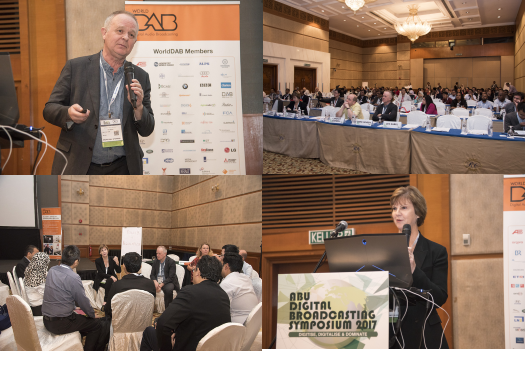Over 140 industry professionals from 20 different countries joined the DAB+ workshop at ABU DBS this year, discussing the progress of DAB+ in the region, hybrid radio, the business case for implementing DAB+ and the benefits of DAB+ in smartphones.
Titled “DAB+ expansion in Asia Pacific”, the WorldDAB workshop also featured three breakout sessions, during which delegates discussed key aspects of DAB+ rollout: regulation, technology and developing new content.
During breakout sessions, attendees discussed challenges including: spectrum management across borders, the impact of the self-driving car and the cost of delivering radio over mobile data.
Joan Warner, Asia Pacific Chair of WorldDAB and CEO of Commercial Radio Australia told attendees “Australia leads the way for DAB+ in Asia Pacific, with 3.6 million listeners.”
“Radio is facing new competitors that we didn’t know about a few years ago, but we are finding new ways to take them on. Radio stations are multiplatform entertainment brands, with personalities, local information and identities… this sets us apart from pure play music services.”
She explained how DAB+ is significantly cheaper to broadcast than FM and how Australian broadcasters are leveraging their broadcast signals to widen audiences and generate more revenue. With Australian broadcasters sharing multiplex transmission facilities, Warner said there has been “no problems between broadcasters who are sharing infrastureture.”
Indonesia launched trial services in April 2016, DAB+ trials are taking place in Indonesia, New Zealand, Myanmar, and in Malaysia a trial local DAB+ multiplex is on air in Kuala Lumpur shared by public and commercial broadcasters. Trials are planned for Vietnam and Thailand.
Speaking at the workshop, World DAB’s Bernie O’Neill outlined a range of countries across Asia already broadcasting in DAB or undertaking trials.
“This has been a landmark year for DAB+,” said O’Neill.
“Around the world there are 36 countries with DAB services on air. 405 million people can listen to DAB stations and 55 million receivers have been sold so far.
“The Norway switch off has given impetus to DAB listening and receiver sales. The next country to switch off analog will be Switzerland, from 2020. Some parts of Italy will also be decommissioning FM antennas by the end of 2017.
“There is increased activity across Asia Pacific and other regions of the world. Australia leads the way, Hong Kong launched in 2011 and Indonesia launched in 2016. There are a range of trials across Asia. The Middle East and Africa are also showing significant activity.
“There are now 2,070 DAB radio stations on air around the world.”
O’Neill told delegates that DAB+ receiver prices now start from the equivalent of 70 Malaysian Ringgits.
Nick Piggott from RadioDNS explained Hybrid Radio technology, which enhances services available from DAB transmissions by using the best features of broadcast and IP.
The ABU DBS conference starts on March 7 and, for the first time, WorldDAB is hosting a DAB+ Pavilion in partnership with key supply-chain companies with a footprint in the region.
The programme features several DAB+ sessions, including an update from Norway’s digital switchover, DAB+ in smartphones and new content being delivered via DAB+.
The BBC’s Lindsay Cornell explained the new ETSI standards for digital radio (see previous report).
“People didn’t use the complicated elements of the standard so we took them out, to give us a base for the future by improving the popular features and taking out those elements that are not used,” he said.
In the UK, a receiver tick mark has been introduced to help consumers decide what they want to buy. “The idea is to give the public a simple thing to help them understand that this radio will give consumers what they need,” explained Cornell.
NRK’s Jorn Jensen spoke about the switch off of analog services that is taking place this year in Norway.
On 11 January this year, the first district was switched off, and other regions of the country will be progressively have their FM stations turned off throughout the year. The switch off began in less populated areas and is moving to larger cities during the year.
By December 18th 2017, all analog radio services will be switched off in Norway.
A website has been launched to keep people informed of progress.
“Radio is very healthy in Norway. There was no pressing need to switch off FM, but we decided to do so as we looked to the future. FM frequencies were full, there was no space for new stations, so that forced us to look ahead,” said Jensen.
The switch over team is doing all they can to make sure that all Norway’s citizens know about the switch off and will be ready for it.
“We visit shops, we meet bus drivers and go out with the fishing fleet to help them install DAB radios and show them how to use them. They can now tune into stations that could never have been there in the past… In Norway, 74% of population have one or more DAB radios.
“Why did we do this? To secure the future of radio,” he said.
Jensen displayed a newspaper headline that (translated) said: “Now the DAB critics are fading away.”
“We even made the news on the day of Donald Trump’s first press conference,” he joked, showing a screen shot from CNN featuring the Norwegian switchoff in the news crawler below Trump.

A range of DAB+ receivers were on show at #DBS2017, the largest amount of commercially available digital radio receivers on the market worldwide.

